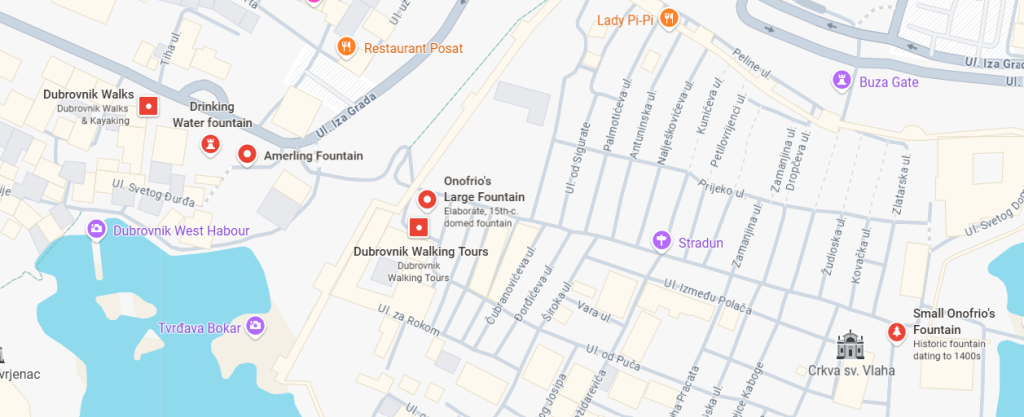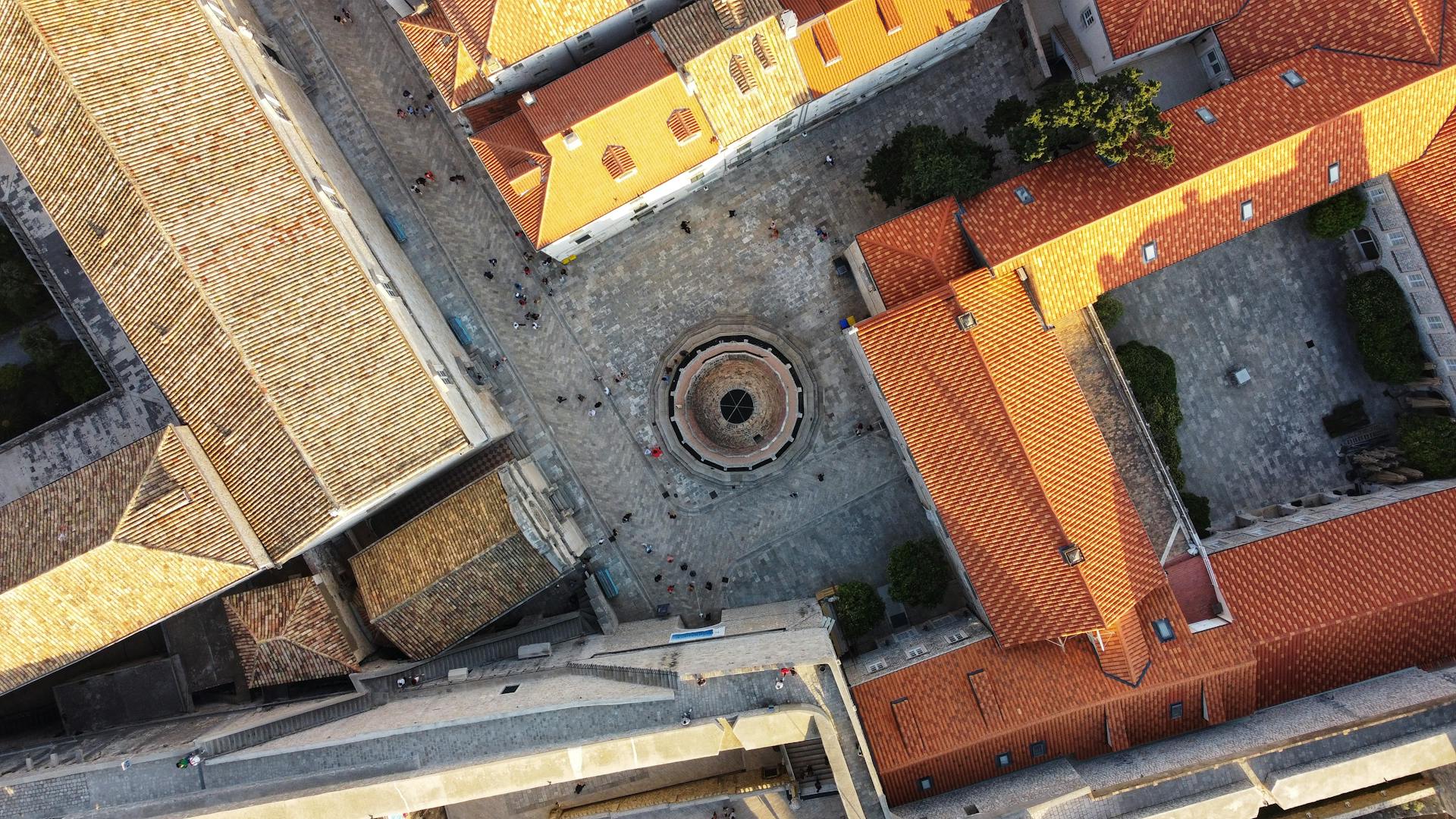Can you drink the water in Dubrovnik?
In Dubrovnik’s summer heat, you’ll probably want water with you at all times. But, can you drink the water in Dubrovnik? Yes, you don’t need to depend on pricey bottled water. The city’s tap water is safe to drink and available almost everywhere.
It comes from a protected spring just a few kilometers away, passes through a modern treatment system and is tested daily to meet EU quality standards. You can fill your bottle before heading out, drink straight from the tap and know the water meets the same safety standards locals rely on every day. However, there are some details it’s good to know, so keep on reading.
Is tap water in Dubrovnik safe to drink?
Yes, tap water in Dubrovnik is completely safe to drink and locals use it daily without hesitation.
You can drink directly from the tap in hotels, apartments, restaurants and public fountains. If you prefer extra reassurance, carry a reusable bottle and refill it yourself rather than buying bottled water. Not only will you save money, but you’ll also avoid contributing to plastic waste, which is a growing issue in coastal areas.
The city’s water supply is monitored by the Dubrovnik Public Water Company (called Vodovod Dubrovnik) under strict European Union drinking water standards. Water samples are taken and tested regularly to ensure they remain free from harmful bacteria and contaminants.
The water is disinfected using carefully measured amounts of chlorine and sodium hypochlorite, which are common in municipal water treatment. The levels are low enough that they don’t noticeably affect taste, but high enough to prevent microbial growth, even in hot weather.
In 2021, Dubrovnik completed major upgrades to its water purification system, which added advanced filtration, UV sterilization, and mineral balance control. This means that throughout all the seasons, even during periods of heavy rain, which in the past sometimes caused temporary cloudiness in the tap water, the water now remains clear and drinkable.
Learn more about the fascinating history of Dubrovnik’s water purification system.
Where does Dubrovnik’s water come from?
Dubrovnik’s drinking water comes almost entirely from the River Ombla, a unique natural phenomenon located just 5 km northeast of the city center. Ombla is considered one of the shortest rivers in the world, flowing only about 30 meters before meeting the Adriatic Sea. Despite its size, it supplies water to the entire Dubrovnik area.
The Ombla spring is part of Europe’s largest karst hydrological system, a network of underground rivers that filter rainwater through layers of limestone before it surfaces. This natural filtration removes impurities and gives the water a clean, lightly mineralized taste.
The water is collected at the spring, processed in a modern treatment plant and distributed through a closed pipeline network to homes, businesses, as well as public fountains across Dubrovnik. Since the system is fed by a reliable underground source rather than surface reservoirs, the risk of contamination is low and supply remains steady even in the height of summer.
If you’re interested in seeing where your drinking water comes from, the area around the Ombla spring in Rijeka Dubrovačka is a scenic spot for a short excursion. The location is easily accessible by car, taxi or local bus, and the combination of the spring, small waterfalls and historic mills makes it a pleasant break from the city crowds.
Where can you drink the water in Dubrovnik Old Town?
As we already stressed out, you don’t need to buy bottled water while exploring the Old Town since public fountains here provide free, safe drinking water. These fountains are connected to the same municipal system as homes and hotels, so the water is just as clean.
Key fountains you can use:
- Large Onofrio’s Fountain – Located just inside Pile Gate, this 16-sided stone fountain has been supplying water since 1438. It’s one of the first things you’ll see when entering the Old Town from the west.
- Small Onofrio’s Fountain – Found at the eastern end of Stradun, near Luza Square. It’s less crowded than its larger counterpart, making it easier to refill your bottle during busy hours.
- Amerling/Rendić Fountain – At Pile Gate, outside the Old Town walls. Convenient if you’re waiting for transport or starting your walk into the city.
- Međed Fountain – Near Ploče Gate. Originally built for traders entering the city, it still provides a steady flow of fresh water.
- Additional smaller fountains are scattered around side streets and squares, locals will point you to them if you ask or you can check them out on the map below.

Bring a reusable water bottle, preferably metal or sturdy plastic and hold it directly under the spout. The flow is continuous, so you don’t need to touch any handles, which makes it more hygienic. The water is cold year-round and especially refreshing on hot days.
Bottled water in the Old Town can be expensive, often €2–3 for 0.5 liters. By refilling at fountains, you can stay hydrated for free, reduce plastic use, and enjoy water with a history. Just imagine, some of these fountains have been in operation for nearly six centuries.
Ordering water in restaurants and cafés
While Dubrovnik’s tap water is safe, it’s not common for restaurants to automatically serve it at the table. In most dining spots, you’ll be offered bottled water, either “mala” (small, 0.33–0.5L) or “velika” (large, 0.75–1L) and charged accordingly. Still and sparkling options are available, with local brands like Jana, Jamnica and Studena on most menus.
If you prefer tap water, simply ask for “voda iz pipe” (voh-dah eez pee-peh), meaning “water from the tap”. Some restaurants will bring it without hesitation, while others may refuse, sticking to bottled service. It’s not a reflection of water quality, it’s simply the standard practice in Croatia’s dining culture.
In cafés, things work differently. When you order coffee, it’s customary to receive a small glass of tap water alongside it at no extra charge. This is especially welcome in summer, when sitting outside on sunny terraces.
The taste of Dubrovnik’s water
Dubrovnik’s tap water is often described as crisp, cool, and lightly mineralized. Thanks to the karst limestone it flows through before reaching the taps, the water naturally picks up minerals like calcium and magnesium, which gives it a mild, pleasant taste.
Unlike in some countries where chlorine levels are higher, Dubrovnik’s water has only a faint chlorination, barely noticeable to most drinkers. This means you can drink it straight from the tap without needing filters or chilling it first. It’s also great for making tea, coffee or cooking. The flavors come through cleanly without any chemical aftertaste.
If you’re used to very soft water, you may notice Dubrovnik’s slightly mineral profile. It’s perfectly safe and most visitors enjoy the taste after a day or two.
Bottled water vs. tap water
Bottled water is available in every shop, kiosk, supermarket and restaurant in Dubrovnik. Supermarkets charge around €0.60–€1 for a 1.5L bottle, while tourist areas, as mentioned, often charge €2–€3 for 0.5L.
Popular Croatian bottled water brands include:
- Jana – still water from a deep spring in Sveta Jana, often labeled as premium
- Jamnica – sparkling mineral water with a strong fizz
- Studena – still water with a very neutral taste
- Cetina – sourced from the Cetina River spring in Dalmatia
Reasons to choose tap water over bottled water:
- Cost – free from taps and fountains
- Convenience – readily available everywhere in the city
- Environment – reduces single-use plastic waste
If you do buy bottled water, use the recycling bins located around the Old Town gates, near bus stops and at public squares.
Drinking water across Croatia
The safety of tap water isn’t limited to Dubrovnik, it’s a national standard. Croatia’s drinking water comes mostly from underground springs and aquifers, which makes it one of the cleanest in Europe. Regular testing is done by local water authorities in all regions.
Coastal cities like Split, Zadar and Rijeka source water from springs and rivers with natural filtration, similar to Dubrovnik. Inland cities such as Zagreb and Karlovac often have harder water due to higher mineral content but still meet EU safety standards.
Even on Croatia’s islands, tap water is safe. Many are supplied via undersea pipelines from the mainland, while others use desalination plants or local springs. On smaller or remote islands, particularly during off-season maintenance, it’s worth checking with locals about the current supply.
When to be cautious?
While Dubrovnik’s tap water is reliable, there are a few situations where extra care is sensible:
- Remote villages or rural areas – some households use private wells that aren’t tested as frequently as the public supply
- Small islands during maintenance periods – water may be temporarily supplied by tanker, and taste or clarity might differ
- Outdoor hiking trips – streams and natural springs look tempting, but unless you’ve confirmed with a local that the source is safe, use purification tablets or a portable filter
If you’re in doubt, check with your accommodation host or a nearby shop owner. Locals will always know if there’s a temporary advisory in place.
Staying hydrated the Dubrovnik way
Dubrovnik’s water is safe, but it’s also part of the city’s living history. Fed by the Ombla spring and flowing through stone fountains that have served travelers for centuries, it’s as much a part of the Dubrovnik experience as walking its walls or strolling down Stradun.
Bring a sturdy bottle, refill it at Onofrio’s Fountain and taste the same water locals have trusted for centuries. You’ll stay cool in the summer heat, avoid unnecessary costs and help keep Dubrovnik’s streets a little cleaner by reducing plastic waste.
Photography: Pexels







